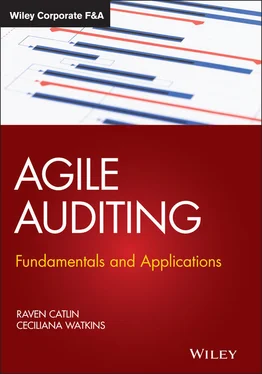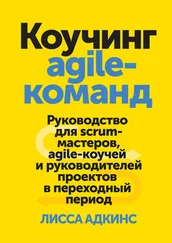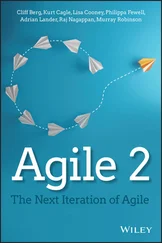From Chapter 4 : What Is Agile Audit? and Chapter 5 : Why Agile Audit? , you will be able to describe what Agile auditing is and why it is beneficial to auditors and the organizations they serve. You will be introduced to the Agile audit framework and implementation options. You will discover some of the challenges encountered, the benefits of Agile, and how to get others to buy in to your Agile auditing methodology.
Chapter 6 : Creating the Agile Mindset will help you develop a deeper understanding of Agile and the Agile mindset. You will also learn ways to assess if your auditors believe in your Agile Manifesto and discover ways to assess how strongly they feel about their ability to start an Agile process. This chapter also provides a recipe for how you can get your auditors to believe in your Agile Manifesto.
Part II: Implementing Agile Auditing provides ideas for and examples of techniques, methods, and practices for implementing Agile auditing and consists of the following five chapters:
In Chapter 7 : Implementing Agile Auditing: Deciding Your Approach and Your Agile Audit Project Roles, you will learn about three different Agile strategies you can use for the implementation of Agile auditing, including full Agile, pilot Agile, and Agile lite. We will also cover Agile audit roles and responsibilities. In this chapter, you will discover challenges you can expect people to encounter as you implement your Agile audit methodology.
In Chapter 8 : Implementing Agile Auditing: The Audit Planning Process, you will see a contrast of traditional annual audit planning using an audit universe and Agile audit planning using a risk universe. This chapter discusses three unconventional risk assessment methods: dynamic risk assessments, data‐driven risk assessments, and risk universe prioritizations. In this chapter, you will also learn more technical Agile jargon in the audit context. This chapter includes two recipes for helping you prioritize and select your user stories, depending on your selected approach to implementing Agile auditing.
Chapter 9 : Implementing Agile Auditing: Planning Agile Audit Engagements explains how to plan your Agile audit resources with self‐managing teams. Further, you will review the Agile planning steps and discuss other Agile jargon specifically for planning activities. You will also learn how you can solve problems encountered during the engagement planning process with Agile auditing.
Chapter 10 : Implementing Agile Auditing: Executing the Agile Audit includes discussing “testing with the audit client” during the execution phase. This chapter will explore workpaper documentation in an Agile audit environment and ideas on managing scope creep. Further, this chapter also discusses how audit findings are communicated in Agile auditing. You will explore and consider the different ways in which you can solve problems encountered during engagement execution or fieldwork process with Agile auditing.
In Chapter 11 : Implementing Agile Auditing: Communicating Agile Audit Results, you will read of innovative means of communicating your audit results and will learn the different communicating activities that derive from Scrum, though applied to Agile auditing. You will have the opportunity to consider whether, with Agile auditing, you still need to write a formal report. You will review problems and explore the different ways you can solve problems encountered during the engagement communication process with Agile auditing.
Part III: Special Considerations provides valuable information regarding how new technologies are affecting the way we audit. You will explore using Learn and Kanban for Agile auditing. You will learn how to stop creating kitchen‐sink audits, merging risk‐based auditing and integrated auditing with Agile auditing. Part IIIconsists of the following eight chapters:
Chapter 12 : Agile Auditing in the “New Normal” Environment (Remote Auditing) presents in a thought‐provoking fashion how Agile audit in the “new normal” must adopt and embrace disruptive technologies (robotics process automation, machine learning, and artificial intelligence) to be prepared to deal with global changes including the 2020–2021 COVID‐19 global pandemic. You will explore how existing technologies, such as videoconferencing and data analytics (DA), change the way we communicate and perform our audits. Also, you will examine techniques for effective virtual conferencing. This chapter provides an introduction to DA terminology and a synopsis of the DA process. You can consider using it as your recipe for starting your DA journey. This chapter examines some of the differences between these technologies and how they affect the way we work.
In Chapter 13 : Lean and Agile Auditing, and Chapter 14 : Exploring Kanban Agile Auditing, you will learn how to use these two frameworks with the Agile auditing framework. It is important to note that these are not mutually exclusive, and audit teams may find a merger of frameworks most beneficial.
In Chapter 15 : Merging Risk‐Based Auditing and Integrated Auditing with Agile Auditing , you will review different risk definitions. You will learn how to stop creating kitchen‐sink audits. You will learn about risk‐based auditing and will explore our extreme risk‐based auditing approach. Further, you will realize that Agile auditing does not preclude one from completing integrated audits.
In Chapter 16 : Building the Auditor Toolbelt and Self‐Managing Agile Audit Teams, you will learn the importance of building an auditor toolbelt and filling it with the different skills to become an Agile audit. Also, you will see how using Scrum values can help create a self‐managing Agile auditing team.
Chapter 17 : Preparing Your Organization for Agile Auditing/Creating the Agile Culture explores how behaviors, norms, and perceptions can influence the organization, so it supports Agile auditing. You will learn about the influence a Grateful Agile Leader can have on the organization's culture and the Agile team. You will also learn what the ideal conditions for Agile auditing are.
Chapter 18 : Passing Your Quality Assessment Review (QAR) in an Agile Audit Environment discusses the four areas of most concern regarding your QAR when implementing Agile auditing (independence and objectivity, planning, documentation, and supervision). It also provides an overview of the standards used for the three types of audits covered in this book.
In Chapter 19 : Nuggets for Agile Audit Success , you are encouraged to summarize your new or refreshed knowledge from the book and identify your nuggets (which can be anything meaningful to you: an idea, a question, something to research later, something to tell someone else, an aha moment, or even a thought related to the content discussed). This chapter provides 10 nuggets for Agile auditing success.
Appendix A: Glossary of Terms, provides definitions of key words, concepts, and notes provided in this book.
Appendix B: Product Backlog Template, includes the business risks (with likelihood/impact assessments), value proposition, cross‐functional dependencies and relationships to other risks, priority or projected date for the completed audit, resource requirement estimates, and an estimate of the effort to complete the Agile audit.
Appendix C: Agile Audit Example . This example consists of the Agile Audit time‐lapse activities conducted during a one‐week period for an Agile audit of remediation activities for a Security/Access Controls audit finding: Deficiencies in the user provisioning process for terminations .
Читать дальше











